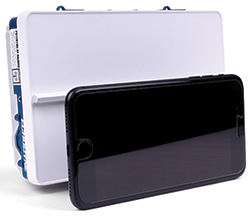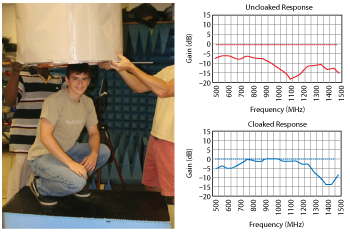
Figure 7 Echodyne’s radar vision unit next to an iPhone.
Traditional satellite dishes are heavy, large, expensive, consume a lot of power and have mechanical gimbals for steering, which have prevented or limited their adoption on most mobile platforms. Kymeta’s mTenna technology provides software-enabled, metamaterials-based, electronic beamforming satellite solutions that are flat, lightweight, small and use software to steer instead of mechanical parts.
This technology is being used to deliver internet connectivity to industries that have historically been inaccessible or difficult for the satellite industry to address, such as rail, bus and automotive. Also, the maritime and aviation markets have struggled to implement satellite technology broadly across smaller vessels and aircraft.
A second company, Echodyne, has developed metamaterial arrays for radar using similar antenna technology to Kymeta but optimized for radar applications. Echodyne’s radar vision platform represents a unique sensor technology that combines the all-weather, long range and ground-truth measurements of radar with high resolution imaging capabilities (see Figure 7).4 Radar vision consists of high performance agile imaging radar hardware combined with computer vision-like software for classification, recognition and perception.
Their metamaterial based, electronically steered array radars operate in the same way as traditional designs, providing high resolution data at any time and in any weather. Like Kymeta’s approach, they can be produced in high volume, at commercial price points and in small lightweight form factors. Their technology can switch in less than 1 μs, has beam shaping and multi-beam capabilities and can steer in both directions, providing near full hemisphere coverage. It operates at 24 GHz and has an operational range of 3.4 km with a field of view ≥120 degrees azimuth and 80 degrees elelvation with a range resolution of 3.25 m and velocity resolution 0.9 m/s.4
LiDAR and cameras have limited range and do not operate reliably in adverse weather, while traditional radar in this sector has inadequate resolution. Echodyne’s radar vision platform represents a new category of sensor technology to enable many autonomous vehicles from drones to cars. Their high performance imaging radar is viable and affordable on commercial and small platforms, including all types of autonomous and unmanned vehicles and machines.

Figure 8 Fractal Antenna’s RF invisibility cloak and measured data.
Fractal Based Antennas
A fractal is “self similar” complex pattern built from the repetition of a simple shape. A fractal element antenna is shaped using fractal geometry. The inherent properties of fractals can enable high performance antennas that can be 50 to 75 percent smaller than traditional antennas. Typical advantages are increased bandwidth, better multi-band performance and higher gain. Fractal antennas can be more reliable and lower cost than traditional antennas because antenna performance is attained through the geometry of the conductor, rather than with the accumulation of separate components or separate elements that can increase the complexity, potential points of failure and cost.
Fractal Antenna is a small company that produces fractal versions of many existing antenna types, including dipole, monopole, patch, conformal, biconical, discone, spiral and helical, as well as compact variants of each that is made possible through fractal technology. They were the first to demonstrate wideband RF invisibility cloaking and used fractal shaped metal patterns on a mylar sheet. In their demonstration, a signal from 750 to 1250 MHz was attenuated by only a fraction of a dB over the same 50 percent bandwidth that would normally be attenuated by 6 to 15 dB without the cloak (see Figure 8).5,6

